Paris Dining: Top Three Baguettes
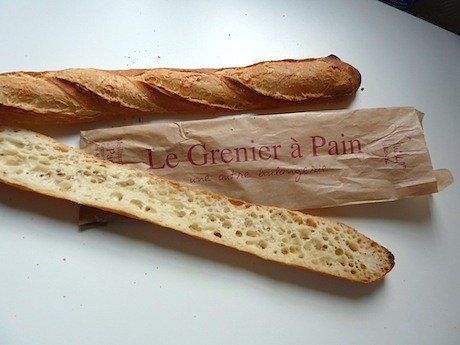
Tue 28 Jan 2014
What can be more iconic of Paris than the baguette? From a buttered slice at breakfast to a sandwich jambon beurre and the ubiquitous bread basket found on practically every dining table, Paris dining seems incomplete without the baguette. Yet it was not that long ago that the baguette became the standard bread in France. Historians date its appearance to only about 1920, round hefty miches and long (one meter or more) breads being more common previously. The baguette was popularized by the French obsession for crust over crumb and gained ground with the postwar trend toward whiter, mass-produced bread that could be made and consumed quickly. It became a bread for urbanites and gradually overshadowed other traditional breads to become the symbol of French bread.
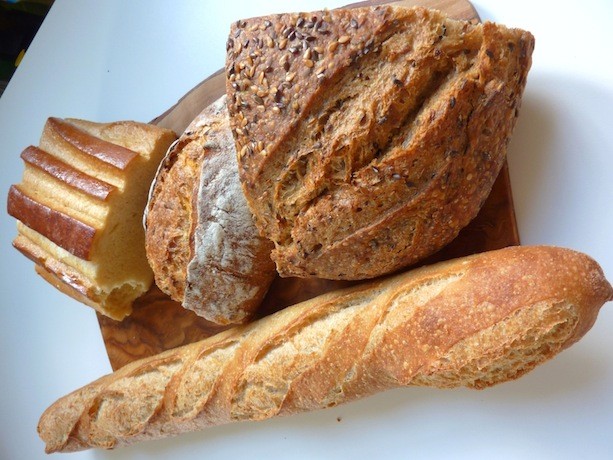
It will immediately become obvious to anyone that not all baguettes are created equal. Why, given that a baguette is essentially 250 grams of flour, water and yeast, can standards swing so wildly? First of all, you would be better off buying a baguette de tradition. A 1993 law stipulates that a pain de tradition should be composed mainly of flour, water and a leavening agent; additives are allowed but limited. It then boils down to the type of flour used and the length of fermentation. If you think your neighborhood boulangerie’s baguette is pretty unique, the sad truth is that it probably isn’t. Concentration in the agri-food industry means that the big players dominate the flour supply chain, and boulangeries increasingly resort to or are imposed on with flour mixes. The better boulangeries seek out quality flour and work with the millers of their choice. A good baguette is also one whose fermentation is not hurried. Sounds simple, but when most baguettes today are mixed vigorously, pumped with gluten and a whole lot of add-ins such that they can be churned out fast, the hands-off approach seems to be a luxury.
The telltale signs of these fast-rise baguettes are a pale, pasty crust, a tight white crumb and a strong yeasty smell. A baguette worthy of its name, on the other hand, should have a caramelized crust that speaks of a bold bake, an irregular creamy interior and an enticing aroma of wheat. It’s hard to speak of the best baguette, as it’s so subjective—airy baguette or more chew? Neutral-tasting so the bread is just a carrier, or a more marked taste? But here are three very good baguettes that will make sure you don’t, well, end up with the shorter end of the stick.
Des Gâteaux et du Pain
This shop may put gâteaux before pain in its name, but make no mistake about it: the breads, especially the baguettes, are winners. They don’t look extraordinary, but the crust has a sharp, firm bite to it. Slice into one and you will see the most beautiful open, creamy crumb with an exquisite taste, thanks, no doubt, to the combination of natural leaven and yeast. And how could it be otherwise, smelling as good as it does, even from more than an arm’s length away. I have never, not once, had a bad baguette from this place, so it gains extra points for consistency.
While there, indulge in pastry chef Claire Damon’s creations, pricey but well worth it.
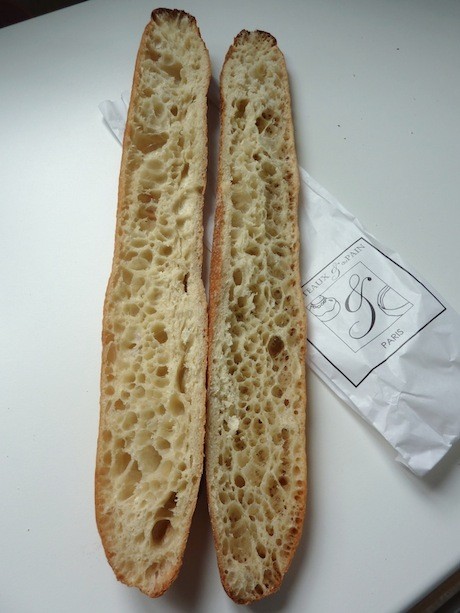
The very open crumb, by most standards, of Des Gâteaux et du Pain’s baguette.
La Gambette à Pain
It may be a bit far out, but you will be well rewarded for trekking there. This boulangerie has beautiful panels and friendly service. Most people do not know that this is where star baker Christophe Vasseur of Du Pain et des Idées picked up his skills from his one-time mentor J-P Mathon. The house baguette, called Gambette, is a slightly darker, chewier affair and is, unusually, made with T80 flour (almost semiwhole wheat), resulting in a speckled interior with much flavor, leagues above the flat-tasting baguettes one usually finds, which rely on sugar, malt, salt and other unnameables to add taste.
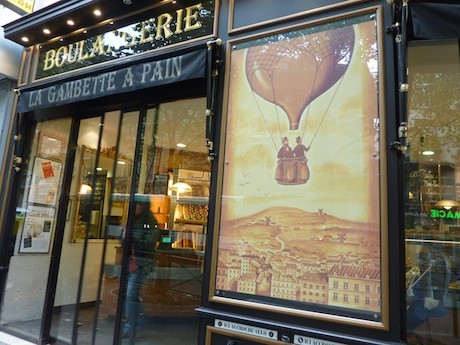
The beautiful facade of La Gambette à Pain, up in the 17th Arrondissement.
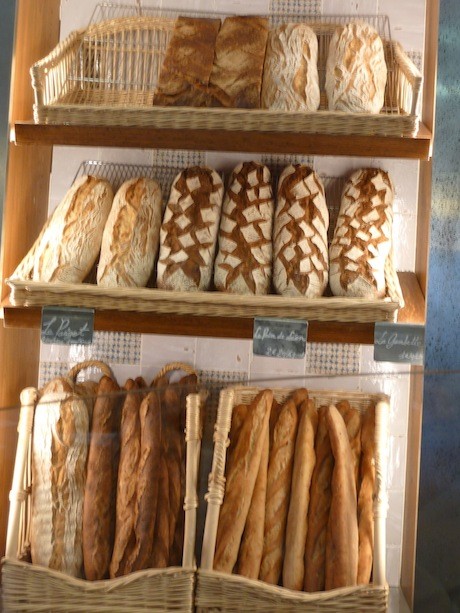
Breads on offer at La Gambette à Pain.
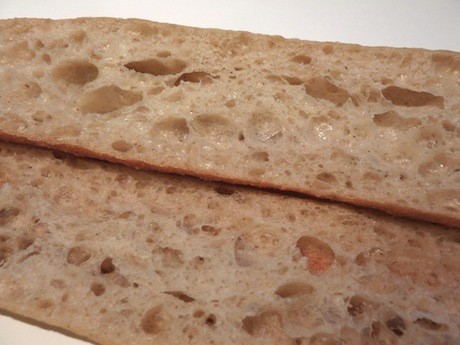 Lovely gelatinized interior o f the Gambette made with T80 flour.
Lovely gelatinized interior o f the Gambette made with T80 flour.
This is about baguettes, but I cannot not tell you about the other delicious things here, namely but not only the pain préféré, a sourdough slab that will knock your socks off, and the Pain Mouna, an orange blossom water–scented brioche.
Grenier à Pain, rue des Abbesses
Michel Galloyer has a number of boulangeries scattered throughout the city, and while I cannot vouch for all of them, the one at rue des Abbesses has a relatively light baguette that can be summed up in two words: pure deliciousness. They won the Meilleure Baguette de Paris competition in 2010, but you need only trust your taste buds. Each time I have to buy two because one will be half eaten by the time I reach the metro.
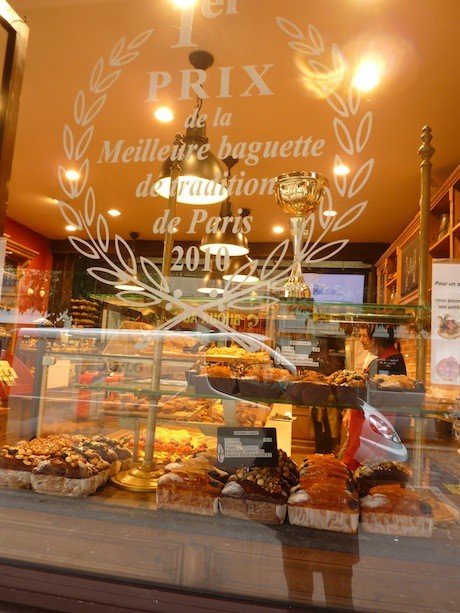
Grenier à Pain—winner of the Meilleure Baguette de Paris prize in 2010.
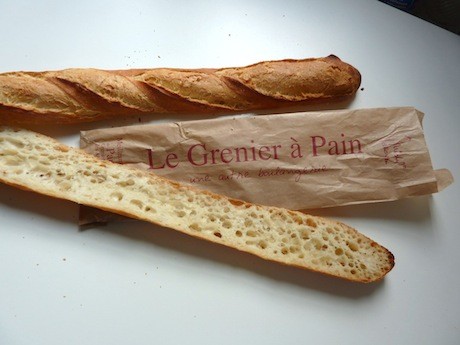
The baguette at Grenier à Pain, a nice mix of lightness and chewiness.
Some Baguette Factoids
• Most baguettes weigh in at 220–250 grams and cost between €0.90 and €1.3.
• Most boulangeries have a plain baguette, a baguette de tradition and usually some variation on the baguette, such as a baguette bio (organic), baguette aux graines (with grains and seeds), baguette au levain (with natural yeast but could also include yeast) or a house specialty.
• Some millers have created specific flour mixes franchised to boulangeries, such as the baguette Rétrodor, Baguepi or Banette.
• Every year, the Ville de Paris organizes a Concours de la Meilleure Baguette de Paris, where bakers and boulangeries submit their best creation to a panel of judges. The best baguette of the year takes home €4,000, the honor of supplying the Élysée for a year and quite a bit of publicity.
• You might be asked when buying your baguette if you would like it bien cuit (well baked) or pas trop cuit (not too browned). Do yourself a favor and choose the former.
Share your own personal favorites with our 20,000-plus Facebook friends. Maybe you have an even better list than we do! Be sure you are signed up for our FREE newsletter, which we send a few times a month, so you can have full access to all gg2p archived articles.
Info/Related Links
Des Gâteaux et du Pain
63, boulevard Pasteur, in the 15th Arrondissement. 01 45 38 94 16.
Closed on Tuesdays.
Good news is that a new branch has recently opened very near le Bon Marché.
89, rue du Bac, in the 7th Arrondissement. 01 45 48 30 74.
La Gambette à Pain
89, avenue Gambette, in the 20th Arrondissement. 01 43 64 52 34.
Closed on weekends.
Grenier à Pain
38, rue des Abbesses, in the 18th Arrondissement. 01 46 06 41 81.
Closed on Tuesdays and Wednesdays.